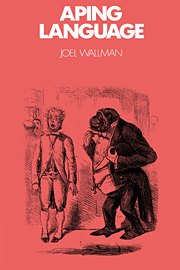2 - History of the ape-language projects
Published online by Cambridge University Press: 03 November 2009
Summary
EARLY STUDIES
Before the Gardners' innovative attempt, described below, to inculcate a visual human language in a nonhuman primate, at least half a dozen projects had been undertaken with the aim of either actively conferring a spoken language on an ape or observing the possible “natural” acquisition of one within a human home environment. The linguistic results in each case were dismal.
Witmer (1909) reported on a chimpanzee that had been trained to approximate crudely the word “mama.” Furness (1916) succeeded, after much labor, in getting an orangutan to utter a discernible “papa” and “cup.” Hayes and Hayes (1951) attained the greatest success among these early projects; at the end of six and a half years of home-raising a chimpanzee, Viki, the Hayeses had managed to teach her to utter “papa,” “mama,” “cup,” and, less successfully, “up.” But Viki's articulation was poor and there was little evidence that these words served a referential, that is, symbolic, function for her.
On the other hand, the apes' “comprehension” of spoken words and phrases substantially exceeded their productive abilities. For example, Gua, a chimpanzee home-reared by the Kelloggs (1933), outpaced the Kelloggs' young son in the number of phrases to which she could respond correctly. This was true up to the end of the fourth month of the study, after which the boy surpassed Gua. Rather than positing understanding, Kellogg (1968) speaks of the chimpanzee “reacting correctly,” but he does not address the question of how much of this reacting could be attributed to linguistic decoding as distinguished from nonlinguistic cues and contextual information.
- Type
- Chapter
- Information
- Aping Language , pp. 10 - 28Publisher: Cambridge University PressPrint publication year: 1992



